TOYOTA PASEO 1996 Owner's Guide
Manufacturer: TOYOTA, Model Year: 1996, Model line: PASEO, Model: TOYOTA PASEO 1996Pages: 165, PDF Size: 2.57 MB
Page 31 of 165

29
The SRS airbag system is designed to
activate in response to a severe frontal
impact within the shaded area be-
tween the arrows in the illustration.
The SRS airbags will deploy if the severity
of the impact is above the designed
threshold level, comparable to an approxi-
mate 20 km/h (14 mph) collision when im-
pacting straight into a fixed barrier that
does not move or deform.
If the severity of the impact is below the
above threshold level, the SRS airbags
may not deploy. However, this threshold velocity will be
considerably higher if the vehicle strikes
an object, such as a parked vehicle or sign
pole, which can move or deform on im-
pact, or if it is
involved in an underride col-
lision (e.g. a collision in which the nose of
the vehicle underridesº, or goes under, the bed of a truck.) It is possible with collision severity at the marginal level of airbag sensor detection
and activation that only one of your ve-
hicle's two airbags will deploy.
For the safety of all occupants, be sure to
always wear seat belts.The SRS airbags are not designed to inflate if the vehicle is subjected to a
side or rear impact, if it rolls over, or if
it is involved in a low-speed frontalcollision.
Page 32 of 165
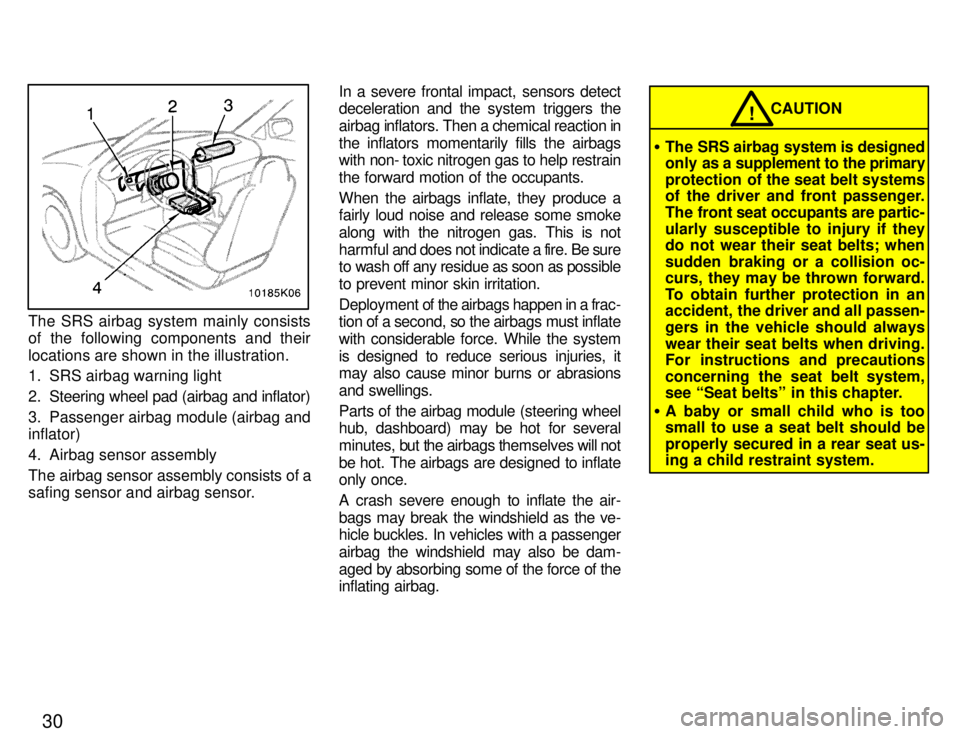
30
The SRS airbag system mainly consists
of the following components and their
locations are shown in the illustration.
1. SRS airbag warning light
2. Steering wheel pad (airbag and inflator)
3. Passenger airbag module (airbag and inflator)
4. Airbag sensor assembly
The airbag sensor assembly consists of a
safing sensor and airbag sensor.In a severe frontal impact, sensors detect
deceleration and the system triggers the
airbag inflators. Then a chemical reaction in
the inflators momentarily fills the airbags
with non- toxic nitrogen gas to help restrain
the forward motion of the occupants.
When the airbags inflate, they produce a
fairly loud noise and release some smoke
along with the nitrogen gas. This is not
harmful and does not indicate a fire. Be sure
to wash off any residue as soon as possible
to prevent minor skin irritation.
Deployment of the airbags happen in a frac-
tion of a second, so the airbags must inflate
with considerable force. While the system
is designed to reduce serious injuries, it
may also cause minor burns or abrasions
and swellings.
Parts of the airbag module (steering wheel
hub, dashboard) may be hot for several
minutes, but the airbags themselves will not
be hot. The airbags are designed to inflate
only once.
A crash severe enough to inflate the air-
bags may break the windshield as the ve-
hicle buckles. In vehicles with a passenger
airbag the windshield may also be dam-
aged by absorbing some of the force of the
inflating airbag.
CAUTION!
� The SRS airbag system is designed
only as a supplement to the primary
protection of the seat belt systems
of the driver and front passenger.
The front seat occupants are partic-
ularly susceptible to injury if they
do not wear their seat belts; when
sudden braking or a collision oc-
curs, they may be thrown forward.
To obtain further protection in an
accident, the driver and all passen-
gers in the vehicle should alwayswear their seat belts when driving.
For instructions and precautions
concerning the seat belt system,
see Seat beltsº in this chapter.
� A baby or small child who is too
small to use a seat belt should be
properly secured in a rear seat us- ing a child restraint system.
Page 33 of 165
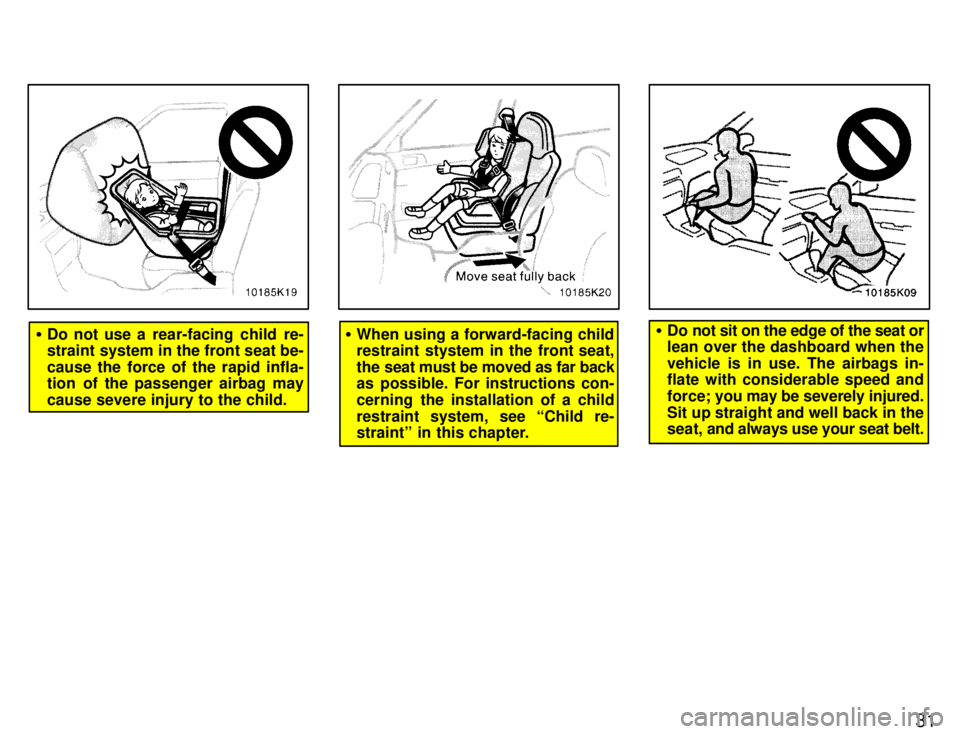
31
�Do not use a rear-facing child re-
straint system in the front seat be- cause the force of the rapid infla-
tion of the passenger airbag may cause severe injury to the child.�When using a forward-facing child
restraint stystem in the front seat,
the seat must be moved as far back
as possible. For instructions con-
cerning the installation of a child
restraint system, see Child re-
straintº in this chapter.�Do not sit on the edge of the seat or
lean over the dashboard when the
vehicle is in use. The airbags in-
flate with considerable speed and
force; you may be severely injured.
Sit up straight and well back in the seat, and always use your seat belt.
Page 34 of 165
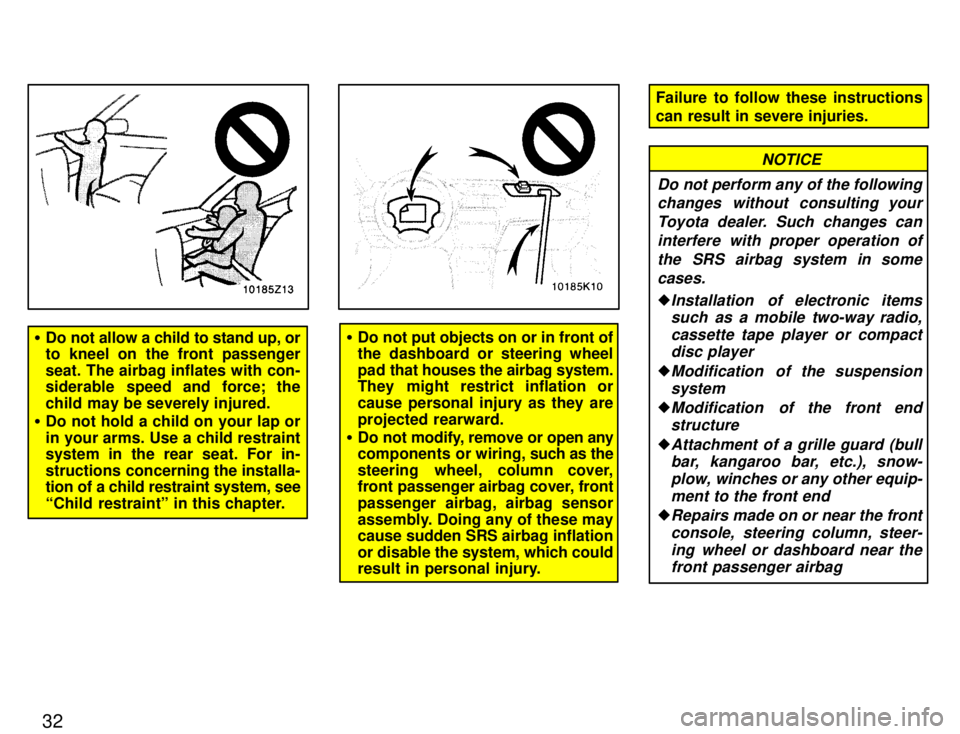
32
�Do not allow a child to stand up, or
to kneel on the front passenger seat. The airbag inflates with con-
siderable speed and force; the
child may be severely injured.
� Do not hold a child on your lap orin your arms. Use a child restraint
system in the rear seat. For in-
structions concerning the installa- tion of a child restraint system, see
Child restraintº in this chapter.�Do not put objects on or in front of
the dashboard or steering wheel
pad that houses the airbag system.
They might restrict inflation or cause personal injury as they are
projected rearward.
� Do not modify, remove or open any
components or wiring, such as the
steering wheel, column cover,
front passenger airbag cover, front
passenger airbag, airbag sensor
assembly. Doing any of these may cause sudden SRS airbag inflation or disable the system, which could
result in personal injury.
Failure to follow these instructions
can result in severe injuries.
Do not perform any of the following
changes without consulting your
Toyota dealer. Such changes can interfere with proper operation ofthe SRS airbag system in some cases.
�Installation of electronic itemssuch as a mobile two-way radio,
cassette tape player or compactdisc player
�Modification of the suspension
system
�Modification of the front endstructure
�Attachment of a grille guard (bullbar, kangaroo bar, etc.), snow-
plow, winches or any other equip-
ment to the front end
�Repairs made on or near the frontconsole, steering column, steer-ing wheel or dashboard near thefront passenger airbag
NOTICE
Page 35 of 165

33
This SRS airbag system has a service re-
minder indicator to inform the driver of op-
erating problems. If either of the following
conditions occurs, this indicates a mal-
function of the airbags. Contact your To-
yota dealer as soon as possible to service
the vehicle. � The light does not come on when the
ignition key is turned to the ACCº or
ONº position, or remains on.
� The light comes on while driving.In the following cases, contact your Toyo-
ta dealer as soon as possible: �The SRS airbags have been inflated.
� The front part of the vehicle (shaded in the illustration) was involved in an ac-
cident not of the extent to cause the
SRS airbags to inflate.
� The pad section of the steering wheel
or front passenger airbag cover
(shaded in the illustration) is scratched,
cracked, or otherwise damaged.The SRS (Supplemental Restraint Sys-
tem) airbag is designed to provide fur-
ther protection to the driver when add-
ed to the primary protection providedby the seat belt.
In response to a severe frontal impact, the
SRS airbag works together with the seat belt to help prevent or reduce injury by in-
flating, in order to decrease the likelihood
of the driver's head or chest directly hitting the steering wheel.
SRS airbag (for Canada)
Page 36 of 165

34
This indicator comes on when the
ignition key is turned to the ACCº or
ONº position. It goes off after about 6
seconds. This means the SRS airbag
is operating properly.
The SRS airbag warning light system
monitors the airbag sensor assembly, in-
flator, warning light, interconnecting wir-
ing and power sources.The SRS airbag system is designed to
activate in response to a severe frontal
impact within the shaded area be-
tween the arrows in the illustration.
The SRS airbag will deploy if the severity
of the impact is above the designed
threshold level, comparable to an approxi-
mate 20 km/h (14 mph) collision when im-
pacting straight into a fixed barrier that
does not move or deform.
If the severity of the impact is below the
above threshold level, the SRS airbag
may not deploy. However, this threshold velocity will be
considerably higher if the vehicle strikes
an object, such as a parked vehicle or sign
pole, which can move or deform on im-
pact, or if it is
involved in an underride col-
lision (a collision in which the nose of the
vehicle underridesº, or goes under, the
bed of a truck).
For your safety, be sure to always wear your seat belt.
Page 37 of 165

35
The SRS airbag is not designed to in-
flate if the vehicle is subjected to a side
or rear impact, if it rolls over, or if it is
involved in a low-speed frontal colli-sion.The SRS airbag system mainly consists
of the following components and their
locations are shown in the illustration.
1. SRS airbag warning light
2. Steering wheel pad (airbag and inflator)
3. Airbag sensor assembly
The airbag sensor assembly consists of a
safing sensor and airbag sensor. In a severe frontal impact, sensors de-
tects
deceleration and the system triggers
the airbag inflator. Then a chemical reac-
tion in the inflator momentarily fills the air-
bag with non-toxic nitrogen gas to help re-
strain the forward motion of the driver. When the airbag inflates, it produces a fairly loud noise and releases some
smoke along with the nitrogen gas. This isnot harmful and does not indicate a fire.
Be sure to wash off any residue as soon
as possible to prevent minor skin irritation.
Deployment of the airbag happens in a
fraction of a second, so the airbag must in-
flate with considerable force. While the
system is designed to reduce serious inju-
ries, it may also cause minor burns or
abrasions and swellings.
The steering wheel hub may be hot for
several minutes, but the airbag itself will
not be hot. The airbag is designed to in-
flate only once.
Page 38 of 165
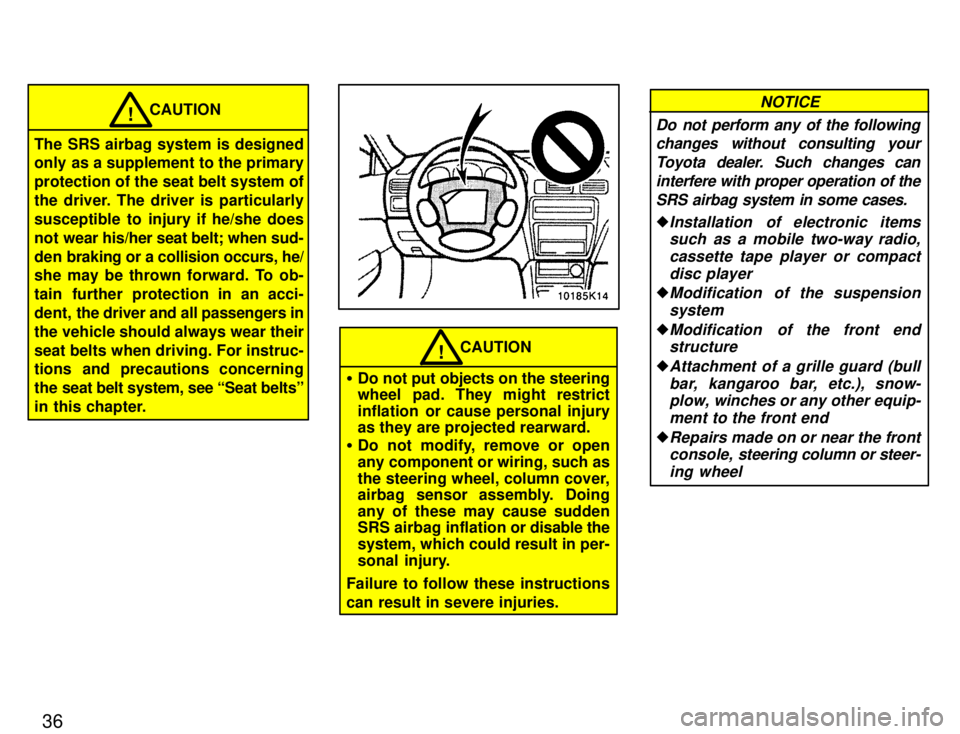
36
CAUTION!
The SRS airbag system is designed
only as a supplement to the primary protection of the seat belt system of
the driver. The driver is particularly
susceptible to injury if he/she does
not wear his/her seat belt; when sud-
den braking or a collision occurs, he/
she may be thrown forward. To ob-
tain further protection in an acci-
dent, the driver and all passengers in
the vehicle should always wear their
seat belts when driving. For instruc-
tions and precautions concerning
the seat belt system, see Seat beltsº
in this chapter.
CAUTION!
� Do not put objects on the steering
wheel pad. They might restrict
inflation or cause personal injury
as they are projected rearward.
� Do not modify, remove or open
any component or wiring, such as
the steering wheel, column cover,
airbag sensor assembly. Doing
any of these may cause sudden
SRS airbag inflation or disable the
system, which could result in per-
sonal injury.
Failure to follow these instructions can result in severe injuries.
Do not perform any of the following changes without consulting your
Toyota dealer. Such changes caninterfere with proper operation of the SRS airbag system in some cases.
�Installation of electronic itemssuch as a mobile two-way radio,
cassette tape player or compactdisc player
�Modification of the suspension system
�Modification of the front endstructure
�Attachment of a grille guard (bull
bar, kangaroo bar, etc.), snow-plow, winches or any other equip-
ment to the front end
�Repairs made on or near the frontconsole, steering column or steer-
ing wheel
NOTICE
Page 39 of 165
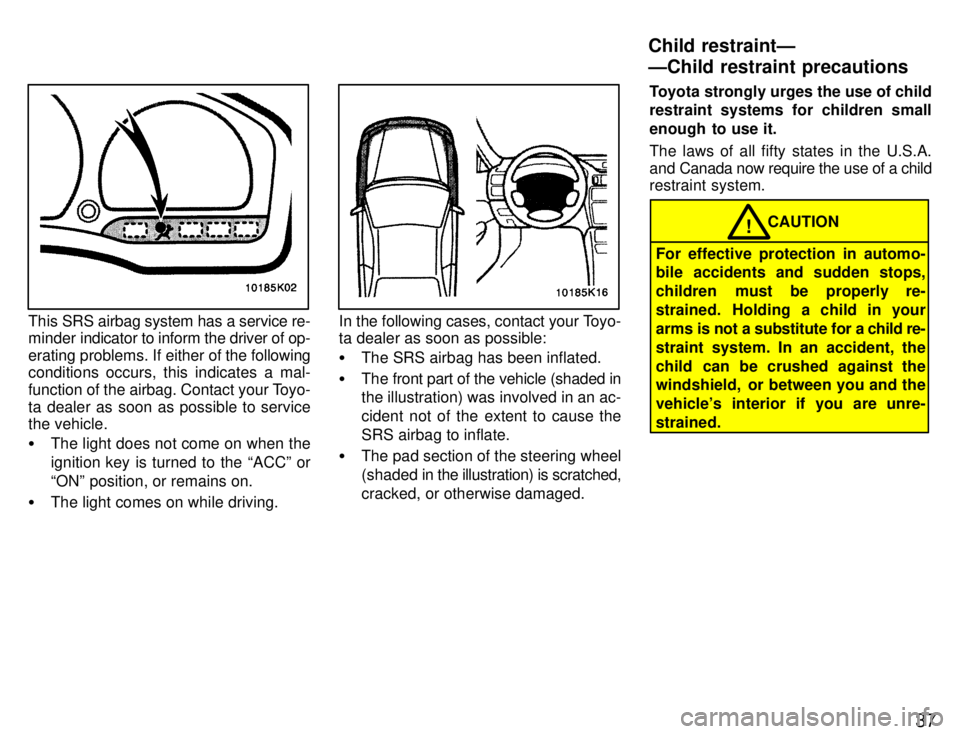
37
This SRS airbag system has a service re-
minder indicator to inform the driver of op-
erating problems. If either of the following
conditions occurs, this indicates a mal-
function of the airbag. Contact your Toyo-
ta dealer as soon as possible to service the vehicle. � The light does not come on when the
ignition key is turned to the ACCº or
ONº position, or remains on.
� The light comes on while driving.In the following cases, contact your Toyo-
ta dealer as soon as possible: �The SRS airbag has been inflated.
� The front part of the vehicle (shaded in the illustration) was involved in an ac-
cident not of the extent to cause the
SRS airbag to inflate.
� The pad section of the steering wheel
(shaded in the illustration) is scratched,
cracked, or otherwise damaged. Toyota strongly urges the use of child
restraint systems for children small
enough to use it.
The laws of all fifty states in the U.S.A.
and Canada now require the use of a child
restraint system.
CAUTION!
For effective protection in automo-
bile accidents and sudden stops,
children must be properly re-
strained. Holding a child in your
arms is not a substitute for a child re-
straint system. In an accident, the
child can be crushed against the
windshield, or between you and the
vehicle's interior if you are unre-strained.
Child restraintÐ ÐChild restraint precautions
Page 40 of 165

37
This SRS airbag system has a service re-
minder indicator to inform the driver of op-
erating problems. If either of the following
conditions occurs, this indicates a mal-
function of the airbag. Contact your Toyo-
ta dealer as soon as possible to service the vehicle. � The light does not come on when the
ignition key is turned to the ACCº or
ONº position, or remains on.
� The light comes on while driving.In the following cases, contact your Toyo-
ta dealer as soon as possible: �The SRS airbag has been inflated.
� The front part of the vehicle (shaded in the illustration) was involved in an ac-
cident not of the extent to cause the
SRS airbag to inflate.
� The pad section of the steering wheel
(shaded in the illustration) is scratched,
cracked, or otherwise damaged. Toyota strongly urges the use of child
restraint systems for children small
enough to use it.
The laws of all fifty states in the U.S.A.
and Canada now require the use of a child
restraint system.
CAUTION!
For effective protection in automo-
bile accidents and sudden stops,
children must be properly re-
strained. Holding a child in your
arms is not a substitute for a child re-
straint system. In an accident, the
child can be crushed against the
windshield, or between you and the
vehicle's interior if you are unre-strained.
Child restraintÐ ÐChild restraint precautions